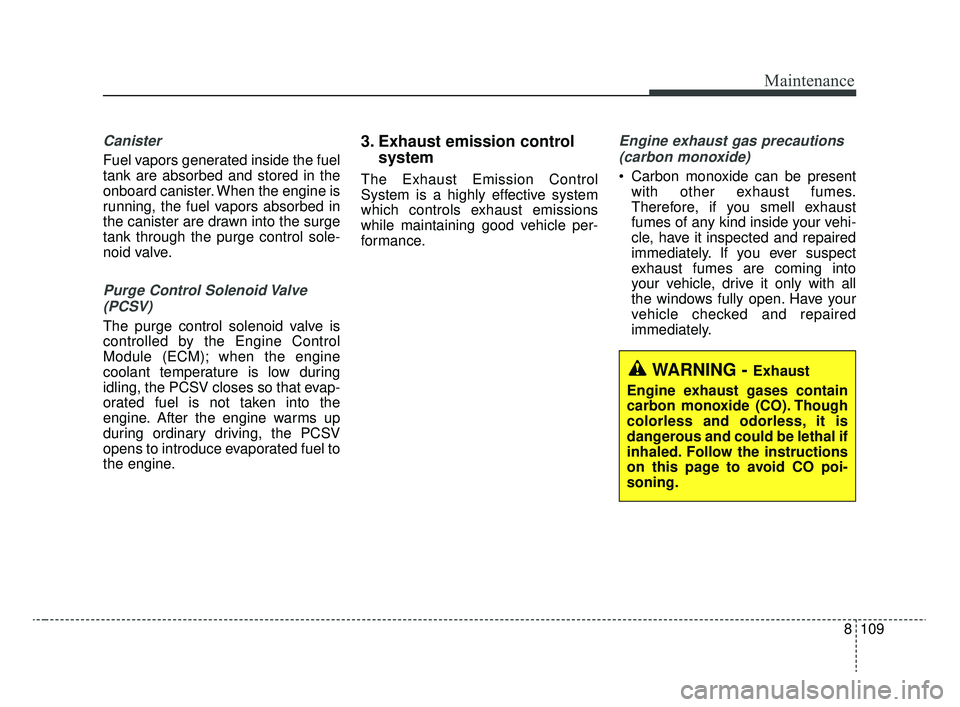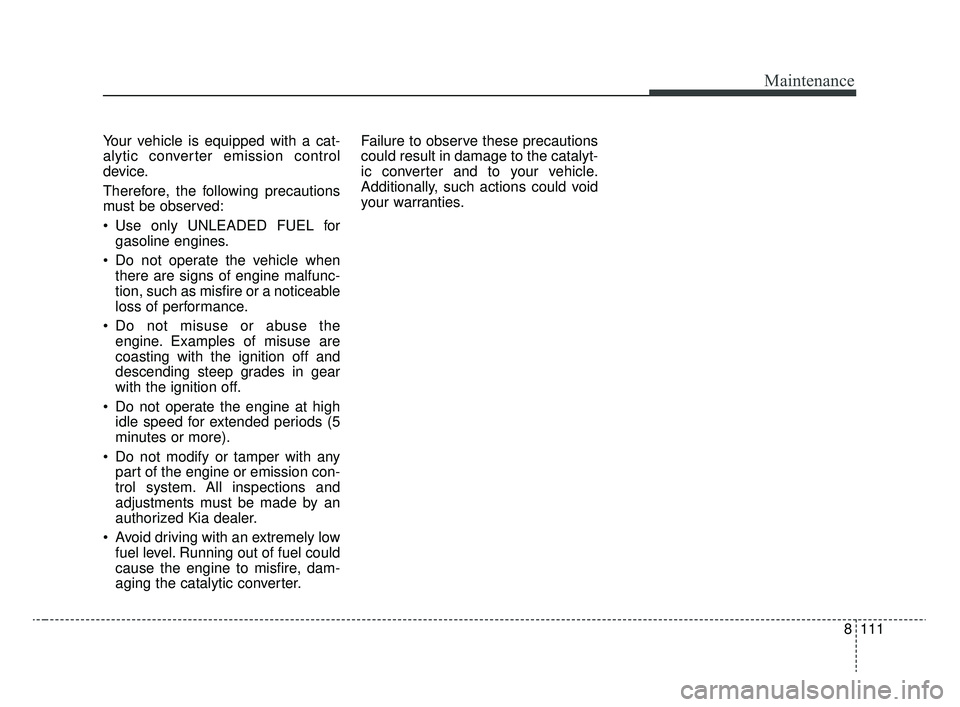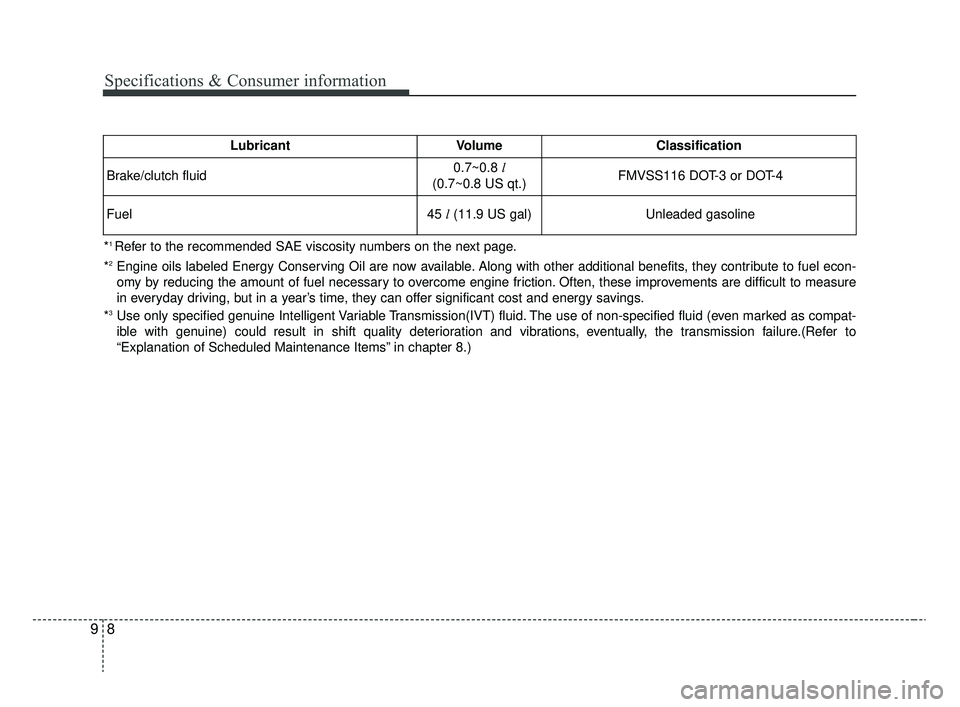2020 KIA RIO Maintenance
[x] Cancel search: MaintenancePage 491 of 516

Maintenance
108
8
EMISSION CONTROL SYSTEM
The emission control system of your
vehicle is covered by a written limited
warranty. Please see the warranty
information contained in the
Warranty & Consumer Information
manual in your vehicle.
Your vehicle is equipped with an
emission control system to meet all
applicable emission regulations.
There are three emission control
systems, as follows.
(1) Crankcase emission control sys-
tem
(2) Evaporative emission control sys- tem
(3) Exhaust emission control system
In order to assure the proper function
of the emission control systems, it is
recommended that you have your
vehicle inspected and maintained by
an authorized Kia dealer in accor-
dance with the maintenance sched-
ule in this manual. Caution for the Inspection and
Maintenance Test (With Electronic
Stability Control (ESC) system)
To prevent the vehicle from mis-
firing during dynamometer test-
ing, turn the Electronic Stability
Control (ESC) system off by
pressing the ESC switch.
After dynamometer testing is completed, turn the ESC system
back on by pressing the ESC
switch again.1. Crankcase emission control system
The positive crankcase ventilation
system is employed to prevent air
pollution caused by blow-by gases
being emitted from the crankcase.
This system supplies fresh filtered air
to the crankcase through the air
intake hose. Inside the crankcase,
the fresh air mixes with blow-by
gases, which then pass through the
PCV valve into the induction system.
2. Evaporative emission con-trol (including ORVR:
Onboard Refueling Vapor
Recovery)
system
The Evaporative Emission Control
System is designed to prevent fuel
vapors from escaping into the atmos-
phere.
(The ORVR system is designed to
allow the vapors from the fuel tank to
be loaded into a canister while refu-
eling at the gas station, preventing
the escape of fuel vapors into the
atmosphere.)
SC CAN (ENG) 8.qxp 6/7/2019 9:44 AM Page 108
Page 492 of 516

8109
Maintenance
Canister
Fuel vapors generated inside the fuel
tank are absorbed and stored in the
onboard canister. When the engine is
running, the fuel vapors absorbed in
the canister are drawn into the surge
tank through the purge control sole-
noid valve.
Purge Control Solenoid Valve(PCSV)
The purge control solenoid valve is
controlled by the Engine Control
Module (ECM); when the engine
coolant temperature is low during
idling, the PCSV closes so that evap-
orated fuel is not taken into the
engine. After the engine warms up
during ordinary driving, the PCSV
opens to introduce evaporated fuel to
the engine.
3. Exhaust emission control system
The Exhaust Emission Control
System is a highly effective system
which controls exhaust emissions
while maintaining good vehicle per-
formance.
Engine exhaust gas precautions
(carbon monoxide)
Carbon monoxide can be present with other exhaust fumes.
Therefore, if you smell exhaust
fumes of any kind inside your vehi-
cle, have it inspected and repaired
immediately. If you ever suspect
exhaust fumes are coming into
your vehicle, drive it only with all
the windows fully open. Have your
vehicle checked and repaired
immediately.
WARNING - Exhaust
Engine exhaust gases contain
carbon monoxide (CO). Though
colorless and odorless, it is
dangerous and could be lethal if
inhaled. Follow the instructions
on this page to avoid CO poi-
soning.
SC CAN (ENG) 8.qxp 6/7/2019 9:44 AM Page 109
Page 493 of 516

Maintenance
110
8
Do not operate the engine in con-
fined or closed areas (such as
garages) any more than what is
necessary to move the vehicle in or
out of the area.
When the vehicle is stopped in an open area for more than a short
time with the engine running,
adjust the ventilation system (as
needed) to draw outside air into the
vehicle.
Never sit in a parked or stopped vehicle for any extended time with
the engine running.
When the engine stalls or fails to start, excessive attempts to restart
the engine may cause damage to
the emission control system.Operating precautions for catalyt-
ic converters (if equipped)
WARNING- Catalytic converter
Keep away from the catalytic
converter and exhaust system
while the vehicle is running or
immediately thereafter. The
exhaust and catalytic systems
are very hot and may burn you.
WARNING- Fire
Do not park, idle or drive the vehicle over or near flamma-
ble objects, such as grass,
vegetation, paper, leaves, etc.
A hot exhaust system can
ignite flammable items under
your vehicle.
Also, do not remove the heat sink around the exhaust sys-
tem, do not seal the bottom of
the vehicle or do not coat the
vehicle for corrosion control.
It may present a fire risk under
certain conditions.
SC CAN (ENG) 8.qxp 6/7/2019 9:44 AM Page 110
Page 494 of 516

8111
Maintenance
Your vehicle is equipped with a cat-
alytic converter emission control
device.
Therefore, the following precautions
must be observed:
Use only UNLEADED FUEL forgasoline engines.
Do not operate the vehicle when there are signs of engine malfunc-
tion, such as misfire or a noticeable
loss of performance.
Do not misuse or abuse the engine. Examples of misuse are
coasting with the ignition off and
descending steep grades in gear
with the ignition off.
Do not operate the engine at high idle speed for extended periods (5
minutes or more).
Do not modify or tamper with any part of the engine or emission con-
trol system. All inspections and
adjustments must be made by an
authorized Kia dealer.
Avoid driving with an extremely low fuel level. Running out of fuel could
cause the engine to misfire, dam-
aging the catalytic converter. Failure to observe these precautions
could result in damage to the catalyt-
ic converter and to your vehicle.
Additionally, such actions could void
your warranties.
SC CAN (ENG) 8.qxp 6/7/2019 9:44 AM Page 111
Page 502 of 516

Specifications & Consumer information
89
*1 Refer to the recommended SAE viscosity numbers on the next page.
*
2Engine oils labeled Energy Conserving Oil are now available. Along with other additional benefits, they contribute to fuel econ-
omy by reducing the amount of fuel necessary to overcome engine friction. Often, these improvements are difficult to measure
in everyday driving, but in a year’s time, they can offer significant cost and energy savings.
*
3Use only specified genuine Intelligent Variable Transmission(IVT) fluid. The use of non-specified fluid (even marked as compat-
ible with genuine) could result in shift quality deterioration and vibrations, eventually, the transmission failure.(Refer to
“Explanation of Scheduled Maintenance Items” in chapter 8.)
LubricantVolumeClassification
Brake/clutch fluid0.7~0.8 l
(0.7~0.8 US qt.)FMVSS116 DOT-3 or DOT-4
Fuel45 l(11.9 US gal)Unleaded gasoline
SC CAN (ENG) 9.qxp 12/12/2019 5:07 PM Page 8
Page 510 of 516

Index
4I
Engine coolant ..............................................................8-23Changing the coolant ..................................................8-25
Checking the coolant level..........................................8-23\
Engine number ..............................................................9-11
Engine oil ......................................................................8-\
21 Changing the engine oil and filter ..............................8-22
Checking the engine oil level ....................................8-21
Engine start/stop button ..................................................6-8 Engine start/stop button position ..................................6-8
Illuminated engine start/stop button ............................6-8
Explanation of scheduled maintenance items ..............8-16
Exterior overview ............................................................2-2
Forward Collision-Avoidance Assist (FCA) system (Radar type) ................................................................6-42Brake operation ..........................................................6-46
FCA system front radar sensor ..................................6-46
FCA system warning message and system control ....6-44
Limitation of the system ............................................6-49
System malfunction ....................................................6-48
Fuel filler door ..............................................................4-42 Closing the fuel filler door..........................................4-\
42
Opening the fuel filler door ........................................4-42 Fuel requirements ............................................................1-3
Do not use methanol ....................................................1-5
Fuel Additives ..............................................................1-5
Gasoline containing alcohol and methanol ..................1-3
Fuses ........................................................................\
......8-55 Engine compartment fuse replacement ......................8-59
Fuse/relay panel description ......................................8-61
Inner panel fuse replacement ......................................8-57
Memory fuse ..............................................................8-58
Hood ........................................................................\
......4-39 Closing the hood ........................................................4-40
Hood open warning ....................................................4-40
Opening the hood ........................................................4-39
How to use this manual ..................................................1-2
If the engine overheats ....................................................7-7
If the engine will not start ..............................................7-4 If engine turns over normally but does not start ..........7-4
If the engine doesn't turn over or turns over slowly ....7-4
If you have a flat tire (with spare tire) ..........................7-27 Changing tires ............................................................7-29
Jack and tools ..............................................................7-27
F
H
I
SC CAN (ENG) Index.qxp 12/12/2019 5:06 PM Page 4
Page 513 of 516

I7
Index
Side repeater lamp (LED type) bulb Replacement....8-82
Stop and tail lamp (LED type) bulb replacement (for 4 door)................................................................8-94
Stop and tail lamp (LED type) bulb replacement (for 5 door)................................................................8-85
Stop and tail lamp bulb replacement (for 5 door) ......8-83
Stop and tail lamp/Side marker (Bulb type) replacement (for 4 door)................................................................8-91
Tail lamp (Bulb type) bulb replacement (for 4 door) ..8-93
Tail lamp (Inside) bulb replacement (for 5 door) ......8-86
Trunk lamp bulb replacement (for 4 door) ................8-95
Vanity mirror lamp bulb replacement ........................8-96
Lighting........................................................................\
..4-92 Battery saver function ................................................4-92
Daytime running light ................................................4-93
Front fog light ............................................................4-97
Headlight escort function ............................................4-92
Headlight welcome function ......................................4-92
High beam operation ..................................................4-95
Lighting control ..........................................................4-93
Turn signals and lane change signals ........................4-96
Maintenance services ......................................................8-5 Owner maintenance precautions ..................................8-6
Owner’s responsibility ..................................................8-5 Manual climate control system....................................4-109
Checking the amount of air conditioner refrigerant and compressor lubricant ..............................................4-118
Climate control air filter ..........................................4-117
Heating and air conditioning ....................................4-110
Sunroof inside air recirculation ................................4-119
System operation ......................................................4-115
Manual transmission ......................................................6-15 Good driving practices ................................................6-17
Manual transmission operation ..................................6-15
Mirrors ........................................................................\
..4-54 Inside rearview mirror ................................................4-54
Outside rearview mirror ..............................................4-54
Owner maintenance ........................................................8-7 Owner maintenance schedule ......................................8-7
Parking brake ................................................................8-28 Checking the parking brake ........................................8-28
M
P
O
SC CAN (ENG) Index.qxp 12/12/2019 5:06 PM Page 7
Page 514 of 516

Index
8I
Rear view monitor system ............................................4-91Rear view monitor function ........................................4-91
Recommended lubricants and capacities ........................9-7 Recommended SAE viscosity number ........................9-9
Remote keyless entry ....................................................4-10 Battery replacement ....................................................4-12
Immobilizer system ....................................................4-14
Limp home (override) procedure ................................4-15
Remote keyless entry system operations ....................4-10
Transmitter precautions ..............................................4-11
Reporting Safety Defects ..............................................9-12
Road warning ..................................................................7-2 Hazard warning flasher ................................................7-2
Scheduled maintenance service ....................................8-10 Scheduled maintenance service precaution ................8-10
Seat ........................................................................\
..........3-4 Driver’s seat ..................................................................3-4
Front passenger’s seat ..................................................3-4
Front seat adjustment ....................................................3-7
Headrest (for front seat) ................................................3-8
Rear seat ........................................................................\
3-4
Rear seat adjustment ..................................................3-11
Seatback pocket ..........................................................3-11 Seat belts ........................................................................\
3-16
Care of seat belts ........................................................3-26
Pre-tensioner seat belt ................................................3-22
Seat belt precautions ..................................................3-24
Seat belt restraint system ............................................3-16
Smart key ........................................................................\
4-6 Smart key functions ......................................................4-6
Smart key precautions ..................................................4-8
Smart trunk (for 4 door) ................................................4-26
Special driving conditions ............................................6-62 Driving at night ..........................................................6-63
Driving in flooded areas ............................................6-65
Driving in the rain ......................................................6-64
Driving off-road ..........................................................6-65
Hazardous driving conditions ....................................6-62
Highway driving ........................................................6-65
Rocking the vehicle ....................................................6-62
Smooth cornering ........................................................6-63
Sport mode integrated control system ..........................6-59 Sport mode ..................................................................6-59
Starting the engine ........................................................6-12 Starting the engine with a smart key ..........................6-13
Starting the engine with an ignition key ....................6-12
Steering wheel...........................................................\
.....4-51 Electric Power Steering (EPS) ....................................4-51
Heated steering wheel ................................................4-53
Horn ........................................................................\
....4-52
Tilt and telescopic steering ........................................4-52
R
S
SC CAN (ENG) Index.qxp 12/12/2019 5:06 PM Page 8